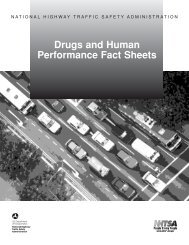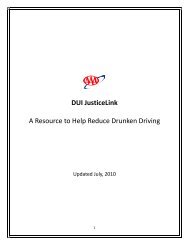2007 National Roadside Survey of Alcohol and Drug Use by Drivers
2007 National Roadside Survey of Alcohol and Drug Use by Drivers
2007 National Roadside Survey of Alcohol and Drug Use by Drivers
Create successful ePaper yourself
Turn your PDF publications into a flip-book with our unique Google optimized e-Paper software.
<strong>2007</strong> <strong>National</strong> <strong>Roadside</strong> <strong>Survey</strong> <strong>of</strong> <strong>Alcohol</strong> <strong>and</strong> <strong>Drug</strong> <strong>Use</strong> <strong>by</strong> <strong>Drivers</strong>: <strong>Drug</strong> ResultsFigure 2. Collecting an Oral Fluid Sample with the Quantisal Oral Fluid Collection Devicedistributed <strong>by</strong> Immunalysis, Inc., Pomona, CA.http://www.immunalysis.com/quantisal_procedure.htmThe oral fluid samples were labeled with pre-printed Chain-<strong>of</strong>-Custody (CoC) labels to be linkedwith the subject <strong>and</strong> additional data collected. This allowed the specimen to be trackedthroughout the project. The CoC labels contained a unique identifier that corresponded to thatsample. This number was also entered into the PDA. CoC numbers were preprinted <strong>by</strong> thelaboratory <strong>and</strong> were used to maintain a documented link between each sample collected <strong>and</strong> therespondent who provided it. A different CoC number was assigned to the oral fluid <strong>and</strong> bloodsample for an individual subject <strong>and</strong> the laboratory was blinded to any link between them. Thisassured the oral fluid <strong>and</strong> blood analyses <strong>and</strong> results were independent <strong>of</strong> one another.The collection <strong>of</strong> oral fluid, while less invasive than the collection <strong>of</strong> blood or urine, has someassociated difficulties (O'Neal, Crouch, Rollins, & Fatah, 2000). Various researchers have notedthat the method <strong>of</strong> collection <strong>and</strong> the medium itself (oral fluid) significantly affect drugconcentration in the specimen <strong>and</strong>, consequently, whether some drugs can be detected at all.However, while some collection devices give no indication <strong>of</strong> the amount <strong>of</strong> oral fluid actuallycollected (rendering a quantitative result meaningless), the Quantisal oral fluid collectiondevice collects 1 mL (+10%) <strong>of</strong> clear oral fluid from the donor. Researchers have studied thedevice to assess the efficiency <strong>of</strong> drug release from the collection pad (Quintela, Crouch, &Andrenyak, 2006; Moore et al., 2006; Moore, Rana, & Coulter, <strong>2007</strong>b) <strong>and</strong> have found a highrate <strong>of</strong> extraction efficiency. Tables 14 <strong>and</strong> 15 summarize the effectiveness <strong>of</strong> the Quantisaloral fluid collection device across a range <strong>of</strong> drugs <strong>by</strong> two different research groups. Findingsabove 100 percent are due to slight variations in the amount <strong>of</strong> the substances actually added tothe scientific control samples (scientific error).28




